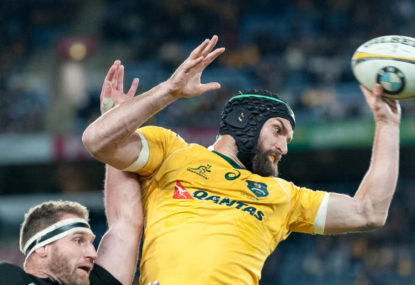Dan Hay
new author
Roar Rookie

Another Wallabies loss at Eden Park would be as welcome as Clyde Rathbone at a Wallabies dinner. New Zealand’s dominance against Australia has its cornerstone in the lineout.
Since their dismal performance against the All Blacks Australia’s lineout has steadily improved.
In the first two Tests against New Zealand this year Australia’s lineout was abysmal. New Zealand have shown again and again an ability to pinch lineout ball against all nations, not just Australia.
Australia, therefore, must devise a method to win all of their ball and furthermore steal 20-30 per cent of New Zealand ball to win matches. Then they face the additional challenge of showing more composure behind the game line which would result in less ball kicked out. This would deprive New Zealand of set piece possession.
In the world cup final last year New Zealand won all fourteen of their own throws. This shows that they forced Australia to kick out on many occasions. Conversely Australia won four of their seven lineouts, with most of the ball they won severely disrupted by Sam Whitlock, Brodie Retallick, Jerome Kaino and Kieran Read. Amazingly Australia still competed deep into the world cup final, while being outpointed in the lineouts, out-enthused in defence, and out-skilled around the park.
In arguably Australia’s finest age of rugby between 1990 to 2003 the Wallabies had strong set pieces. Topo Rodriguez fed his Argentine street smarts into Australia’s burgeoning set piece power, which had a great influence on players such as Rod Lawton, Mark Harthill, Ewen McKenzie, Tony Daly, Phil Kearns, Cameron Lillicrap, Dan Crowley, the Blades Brothers, Rod Moore, Richard Harry, and Bill Young.
In the 1991 world cup we had a world class lineout in John Eales, Rupert McCall and Troy Coker with Simon Poidevin showing his street smarts at the back.

In 1999 we had Eales, David Giffin and Matt Cockbain, and to a lesser extent Owen Finegan and Toutai Kefu. They provided the Australian back with more than their fair share of ball, allowing Larkham and Kefu to both break and bend the line at will.
In 2001 against the Lions Justin Harrison shone at the front of the lineout, and Eales, as ever, was the mailman. Again Cockbain and Kefu were admirable lieutenants.
Some heartening news for Australia is the return of Rory Arnold through Australian provincial rugby. Arnold and Coleman shape as Australia’s best option at lineout time. They are both lineout aces who have yet to play their best rugby.
They could be able supported at the back of the lineout of Lopeti Timani. Maybe an envoy needs to be sent to France to bring back Lopeti’s brother, Siteki, before his best rugby is behind him. Bolstering second-rower stocks has never hurt Australian rugby.
Australia won their fair share of ball against South Africa and Argentina and we saw the potential of Kerevi and Folau.
In the Wellington Test, New Zealand, smelling blood in the water, tried to attack Australia’s scrum. This was not so much an attacking move, but a tactical move. Having beaten Australia soundly in the lineouts New Zealand made an attempt to destroy the morale of Australia’s forward pack by out scrummaging them. Thankfully Australias scrum didn’t implode.
Looking at recent Bledisloe Cup history, between 1980-1991 New Zealand won seven series, Australia two and one series was drawn. Between 1992-2002 Australia won four series, new Zealand four series and three series were drawn.
Between 2003-2016 New Zealand have won ten series and four have been drawn.
Not only do we have lineout woes but Australia is currently lacking depth on the wings. Haylett-Petty’s defensive errors costs Australia badly in the first two Test against the All Blacks. A return to form for Tomane and Speight will be very welcome for the Wallabies.
Cheika continues the dynasty of Cyril Towers, Dwyer and Eddie Jones coaching Randwick-style rugby. So there may be a reluctance to sack him at a higher level.
Maybe it is time to Cheika to take a more Churchillian approach. Maybe he should remind Australia of Kieran Read’s words after New Zealand beat Australia in Ewen Mckenzie’s last Test as coach, the Test where Nic White inexplicably kicked the ball back to the Kiwis with 60 seconds remaining.
Read seemed happier to see the pain on Australians faces than the victory itself. With all great sporting legacies it is normal for triumphalism to emerge. The challenge Cheika has is to blend a new set piece game plan, composure behind the gain line ball and better kicking skills.
More composure behind the gain line can inspire and galvanise Australia when they are deep in battle. Maybe he can quote Rathbone and create a siege mentality as Eden Park approaches.
New Zealand know that if Australia’s backs get their fair share of ball they will compete deep into game. They know every time they deny Australia clean lineout ball they are denying Australia’s outside backs space to attack, which has always been Australia’s strength.
All international sides struggle to contain the Australian sides which get their fair share of ball. Australian sides since Eddie Jones have struggled to show a recognisable attacking style and rhythm of play against new Zealand.
Why? They have been starved of ball. Hopefully Arnold and Coleman can unlock the secret of dismantling New Zealand lineout. We will wait and see.